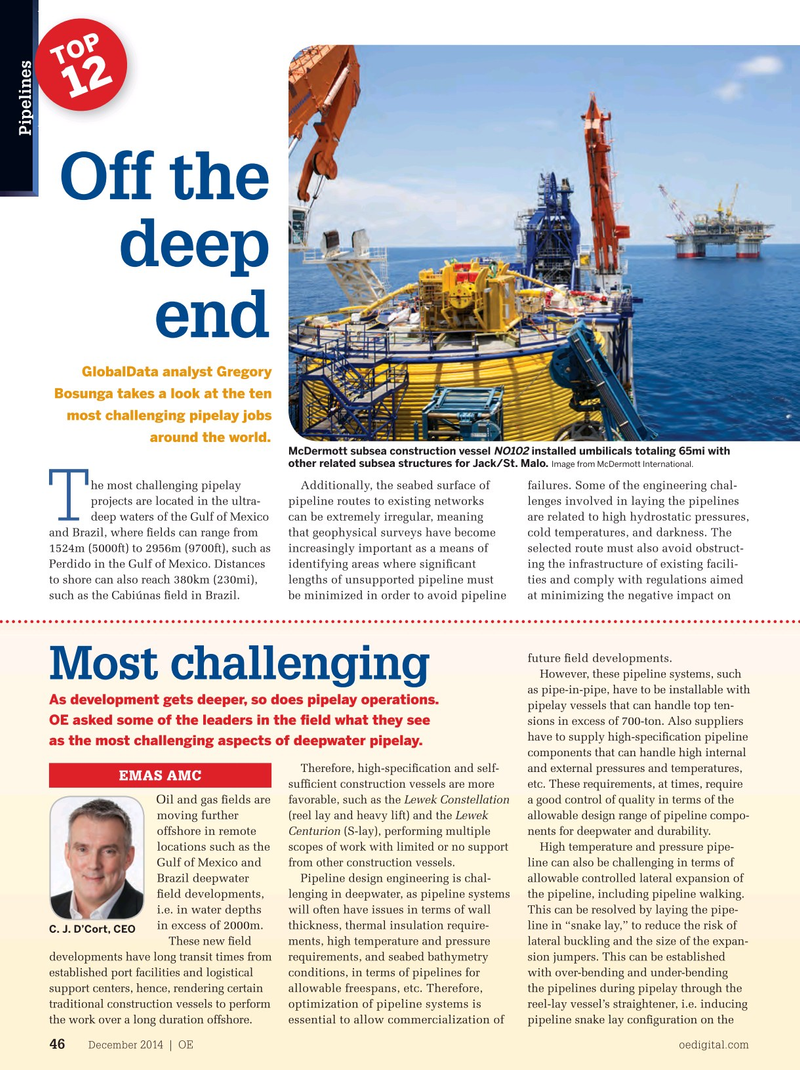
Page 44: of Offshore Engineer Magazine (Dec/Jan 2014)
Read this page in Pdf, Flash or Html5 edition of Dec/Jan 2014 Offshore Engineer Magazine
TOP
Pipeline Project/ Max Water Length Associated Install Associated 12
Field Project depth (ft) (mi)CommodityAssociated FieldStatus Country Year Field Operator
Great White, Silvertip
Perdido (GoM) 9701 8Oil ProducingUnited States2009Shell and Tobago
PipelinesPipelinesPipelines
Under
Stones (GoM) 9586 13 Oil Stones- FPSO United States 2013 Shell
Development
Chinook (GoM) 887711GasCascade -Chinook ProducingUnited States2009Petrobras
Off the
Under
Lucius (GoM) 8755 144 Oil Lucius United States2011Apache
Development
Under
Lucius (GoM) 8755 209 Gas Lucius United States2011Apache
Development
Cascade (GoM) 825052GasCascade -Chinook ProducingUnited States2009Petrobras deep
Cabiunas 7346 236 GasLula (Tupi Caramba)ProducingBrazil 2014 Petrobras
Under
Jack - St Malo 7040 137 Oil St Malo United States 2010 Chevron
Development end
Under
Jack – St Malo 7040152Gas St Malo United States 2010 Chevron
Development
Aracati- Lubnor 7034 73 Gas Carcara ProducingBrazil2012Petrobras
GlobalData analyst Gregory
Cabiunas–Reduc 7000 113 Gas Marlim SulProducingBrazil 2010 Petrobras
Bosunga takes a look at the ten (Gasduc III) most challenging pipelay jobs
NaKika (GoM) 6940 19 Gas Fourier ProducingUnited States2005Shell around the world.
McDermott subsea construction vessel installed umbilicals totaling 65mi with NO102 other related subsea structures for Jack/St. Malo.
Image from McDermott International.
he most challenging pipelay Additionally, the seabed surface of failures. Some of the engineering chal- projects are located in the ultra- pipeline routes to existing networks lenges involved in laying the pipelines
T deep waters of the Gulf of Mexico can be extremely irregular, meaning are related to high hydrostatic pressures, and Brazil, where ? elds can range from that geophysical surveys have become cold temperatures, and darkness. The 1524m (5000ft) to 2956m (9700ft), such as increasingly important as a means of selected route must also avoid obstruct-
Perdido in the Gulf of Mexico. Distances identifying areas where signi? cant ing the infrastructure of existing facili- to shore can also reach 380km (230mi), lengths of unsupported pipeline must ties and comply with regulations aimed such as the Cabiúnas ? eld in Brazil. be minimized in order to avoid pipeline at minimizing the negative impact on future ? eld developments. seabed for controlled lateral expansion.
However, these pipeline systems, such Risers can also be challenging to
Most challenging as pipe-in-pipe, have to be installable with install, as they require high-speci? cation
As development gets deeper, so does pipelay operations. pipelay vessels that can handle top ten- pull-in equipment, such as large pull-
OE asked some of the leaders in the ? eld what they see sions in excess of 700-ton. Also suppliers in winches or chain jacks, to overcome have to supply high-speci? cation pipeline the loads for a second end pipeline as the most challenging aspects of deepwater pipelay.
components that can handle high internal pull-in. This also requires platforms to
Therefore, high-speci? cation and self- and external pressures and temperatures, handle high hang-off loads, which can
EMAS AMC suf? cient construction vessels are more etc. These requirements, at times, require be governing for these types of riser, i.e.
Oil and gas ? elds are favorable, such as the Lewek Constellation a good control of quality in terms of the ? exibles, steel catenary risers or steel moving further (reel lay and heavy lift) and the Lewek allowable design range of pipeline compo- lazy wave risers.
offshore in remote Pipeline end terminations (PLETs) or
Centurion (S-lay), performing multiple nents for deepwater and durability. locations such as the Inline Ts (ILTs) can also be challenging scopes of work with limited or no support
High temperature and pressure pipe-
Gulf of Mexico and to install, heavy duty valve assembly, from other construction vessels. line can also be challenging in terms of
Pipeline design engineering is chal- allowable controlled lateral expansion of
Brazil deepwater corresponding connectors, anchor lenging in deepwater, as pipeline systems the pipeline, including pipeline walking. ? eld developments, ? anges, etc., will be required in deep- will often have issues in terms of wall This can be resolved by laying the pipe- i.e. in water depths water. This normally results in heavy thickness, thermal insulation require- line in “snake lay,” to reduce the risk of in excess of 2000m. duty PLETs or ILTs with large mudmats
C. J. D’Cort, CEO
These new ? eld ments, high temperature and pressure lateral buckling and the size of the expan- that have to be installed from a pipe- developments have long transit times from requirements, and seabed bathymetry sion jumpers. This can be established lay vessel. The Lewek Constellation is established port facilities and logistical conditions, in terms of pipelines for with over-bending and under-bending able to install large PLETs weighing in allowable freespans, etc. Therefore, support centers, hence, rendering certain the pipelines during pipelay through the excess of 100-ton and Centurion has optimization of pipeline systems is traditional construction vessels to perform reel-lay vessel’s straightener, i.e. inducing versatile A-frame that can be used to essential to allow commercialization of the work over a long duration offshore. pipeline snake lay con? guration on the install large PLETs.
December 2014 | OE oedigital.com 46 046_OE1214_Pipelines1and2.indd 46 11/21/14 6:09 PM

 43
43

 45
45